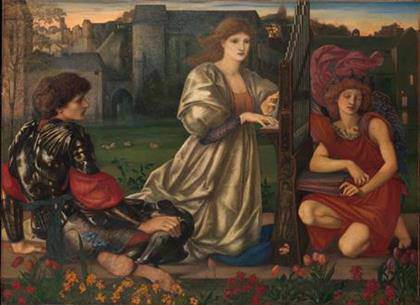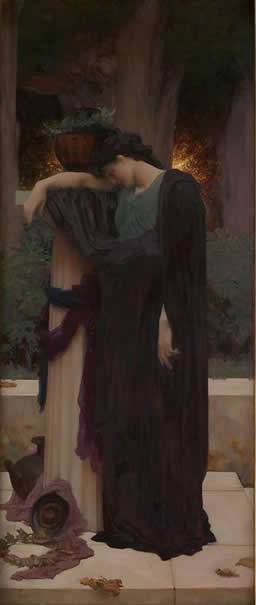
Sir Edward Burne-Jones (British, Birmingham 1833–1898 Fulham)
The Love Song, 1868–77.
Oil on canvas.
The Metropolitan Museum of Art, New York
The Alfred N. Punnett Endowment Fund, 1947 (47.26)

Frederic, Lord Leighton (British, Scarborough 1830–1896 London)
Lachrymae, ca. 1894–95
Oil on canvas.
The Metropolitan Museum of Art, New York
Catharine Lorillard Wolfe Collection, Wolfe Fund, 1896
The Pre-Raphaelite Legacy at the Metropolitan Museum “The Pre-Raphaelite Legacy: British Art and Design” features approximately 30 objects from across the Metropolitan Museum highlighting the key period when the Pre-Raphaelite vision was adapted and transformed. May 20 – October 26, 2014.]]>
Source: Metropolitan Museum of Art
In 1855, Edward Burne-Jones and William Morris, student friends at Oxford, decided to abandon their theological studies and become artists. They turned for guidance to Dante Gabriel Rossetti, a leader of the recently disbanded Pre-Raphaelite Brotherhood (1848–1853), a group that galvanized British painting by rejecting academic convention and sought to emulate the vividness and sincerity of art from before the time of Raphael.
The creative dialogue between Burne-Jones, Morris, and Rossetti was remarkable for its intensity, productivity, and duration, and stimulated fresh goals and styles that defined the second wave of Pre-Raphaelite art, in the key decades from the 1860s through the 1890s.
Works by Burne-Jones anchor the exhibition. His masterpiece The Love Song (1868–77), the Metropolitan Museum’s sole major Pre-Raphaelite painting, is displayed along with an early painted cabinet from 1861 and a late tapestry from 1898, both products of Burne-Jones’s long, fruitful collaboration with Morris. These are united for the first time, along with supporting works by artists ranging from Ford Madox Brown to Aubrey Beardsley and Julia Margaret Cameron, revealing the enduring impact of Pre-Raphaelite ideals as they were taken up by others and developed across a range of media.
The exhibition demonstrates the shared reverence for the past and for beauty that stimulated such diverse endeavors among these artists and their circle as Rossetti’s depiction of sensuous model-muses in poetic guise; Burne-Jones’s evocation of the lofty themes of romance, music, and spirituality; and Morris & Company’s production of decorative works inspired by medieval craft traditions. Painting, design, and, notably, drawing —a lynchpin of the group’s practice— were pursued with equal fervor as a means to restore integrity to the arts.
Today, at a time of renewed appreciation for the Pre-Raphaelites, this exhibition —the first devoted to the subject at the Metropolitan Museum in 15 years— offers an opportunity to consider afresh this aspect of the Museum’s collections.
Related content
Pre-Raphaelite Art and Design at the National Gallery, Washington (exhibition, 2013)
Follow us on:


